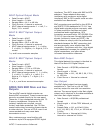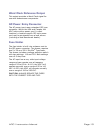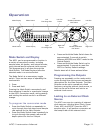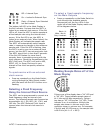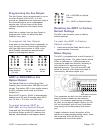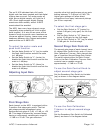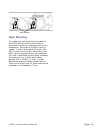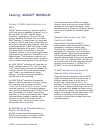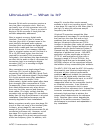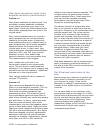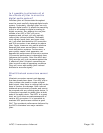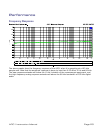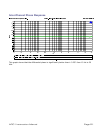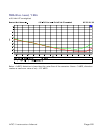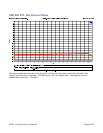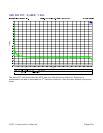
ADC1 Instruction Manual Page 17
UltraLock™ … What is It?
Accurate 24-bit audio conversion requires a
very low-jitter conversion clock. Jitter can
very easily turn a 24-bit converter into a 16-
bit converter (or worse). There is no point in
buying a 24-bit converter if clock jitter has
not been adequately addressed.
Jitter is present on every digital audio
interface. This type of jitter is known as
interface jitter and it is present even in the
most carefully designed audio systems.
Interface jitter accumulates as digital signals
travel down a cable and from one digital
device to the next. If we measure interface
jitter in a typical system we will find that it is
10 to 10,000 times higher than the level
required for accurate 24-bit conversion.
Fortunately, this interface jitter has absolutely
no effect on the audio unless it influences the
conversion clock in an analog-to-digital
converter (ADC) or in a analog-to-digital
converter (DAC).
Many converters use a single-stage Phase
Lock Loop (PLL) circuit to derive their
conversion clocks from AES/EBU, Word Clock,
or Super Clock reference signals. Single-stage
PLL circuits provide some jitter attenuation
above 5 kHz but none below 5 kHz.
Unfortunately, digital audio signals often have
their strongest jitter components at 2 kHz.
Consequently, these converters can achieve
their rated performance only when driven
from very low jitter sources and through very
short cables. It is highly unlikely that any
converter with a single-stage PLL can achieve
better than 16 bits of performance in a typical
installation. Specified performance may be
severely degraded in most installations.
Better converters usually use a two-stage PLL
circuit to filter out more of the interface jitter.
In theory, a two-stage PLL can remove
enough of the jitter to achieve accurate 24-bit
conversion (and some do). However, not all
two-stage PLL circuits are created equal.
Many two-stage PLLs do not remove enough
of the low-frequency jitter. In addition, two-
stage PLL circuits often require several
seconds to lock to an incoming signal. Finally,
a two-stage PLL may fail to lock when jitter is
too high, or when the reference sample
frequency has drifted.
UltraLock™ converters exceed the jitter
performance of two-stage PLL converters, and
are free from the slow-lock and no-lock
problems that can plague two-stage PLL
designs. UltraLock converters are 100%
immune to interface jitter under all operating
conditions. No jitter-induced artifacts can be
detected using an Audio Precision System 2
Cascade test set. Measurement limits include
detection of artifacts as low as –140 dBFS,
application of jitter amplitudes as high as
12.75 UI, and application of jitter over a
frequency range of 2 Hz to 200 kHz. Any
AES/EBU signal that can be decoded by the
AES/EBU receiver will be reproduced without
the addition of any measurable jitter artifacts.
The ADC1, DAC-104 and the ADC-104 employ
Benchmark’s new UltraLock technology to
eliminate all
jitter-induced performance
problems. UltraLock isolates the conversion
clock from the digital audio interface clock.
Jitter on a DAC digital audio input, or an ADC
reference input can never have any
measurable effect on the conversion clock of
an UltraLock converter. In an UltraLock
converter, the conversion clock is never
phase-locked to a reference clock. Instead the
converter oversampling-ratio is varied with
extremely high precision to achieve the
proper phase relationship to the reference
clock. Interface jitter cannot degrade the
quality of the audio conversion. Specified
performance is consistent and repeatable in
any installation!



